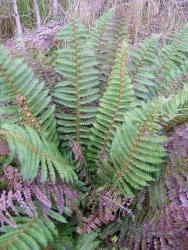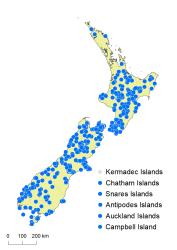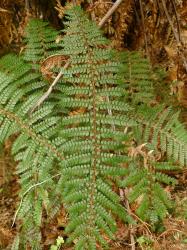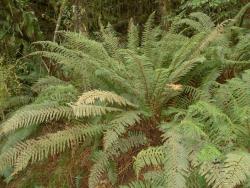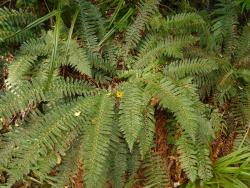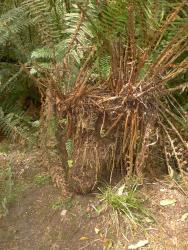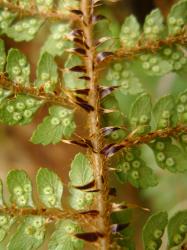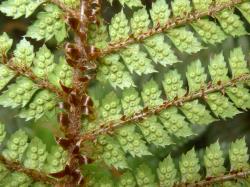- ≡ Polypodium vestitum G.Forst., Fl. Ins. Austr. 82 (1786)
- ≡ Aspidium vestitum (G.Forst.) Sw., J. Bot. (Schrader) 1800(2): 37 (1801)
- ≡ Aspidium aculeatum var. vestitum (G.Forst.) Hook. ex Hook.f., Handb. New Zealand Fl. 375 (1864)
- ≡ Polystichum aculeatum var. vestitum (G.Forst.) Domin, Biblioth. Bot. 20(85): 55 (1913)
- = Polystichum venustum Hombr. in Hombron & Jacquinot, Voy. Pôle Sud, Bot. t. 5 m–n (1844)
- ≡ Aspidium venustum (Hombr.) Hook.f., Bot. Antarct. Voy. I. (Fl. Antarct.) Part I, 106 (1844)
- = Aspidium pulcherrimum Colenso, Tasmanian J. Nat. Sci. 2: 167 (1845)
- = Aspidium waikarense Colenso, Tasmanian J. Nat. Sci. 2: 168 (1845)
- = Aspidium perelegans Colenso, Trans. & Proc. New Zealand Inst. 29: 416 (1897)
- ≡ Polystichum perelegans (Colenso) C.Chr., Index Filic. 87, 586 (1906)
- ≡ Polystichum aculeatum var. perelegans (Colenso) Domin, Biblioth. Bot. 20(85): 56 (1913)
Rhizomes erect, sometimes forming a trunk up to 600 mm tall, densely scaly. Rhizome scales narrowly ovate, 10–40 mm long, 1.3–4.0 mm wide, bicolorous with dark centres and pale margins, margins entire. Fronds 220–1700 mm long [2250 mm long]*. Stipes 45–500 mm long [800 mm long], pale brown, densely scaly throughout; scales usually narrowly ovate to ovate, bicolorous with dark centres and pale margins, apices acuminate, margins entire [or rarely pale brown, concolorous, apices acuminate, margins toothed or ciliate, with only scattered bicolorous scales]. Rachises pale brown, sulcate, narrowly winged only at distal end, abundantly scaly; scales on abaxial surface narrowly ovate and bicolorous [not Chathams] to narrowly ovate or ± linear and pale brown; scales on adaxial surface ovate to ± linear and pale brown. Laminae 2-pinnate or rarely 3-pinnate, narrowly elliptic, 110–1200 mm long [1460 mm long], 48–250 mm wide [480 mm wide], dark shiny green adaxially, paler green abaxially, coriaceous, bearing abundant pale brown or colourless scales on abaxial costae and lamina surfaces, sparsely scaly on adaxial costae, ± glabrous on adaxial lamina surfaces. Primary pinnae in 16–55 pairs below pinnatifid apex, slightly overlapping to widely spaced, narrowly oblong or narrowly triangular; the longest at or near the middle, 25–125 mm long [270 mm long], 8–32 mm wide [50 mm wide], apices acute or acuminate, bases stalked; costae winged distally. Secondary pinnae decreasing in length only near the primary pinna apices; the longest secondary pinnae oblong or ovate, 4–16 mm long [34 mm long], 3–10 mm wide [14 mm wide], apices sharply pointed, margins sharply and often deeply serrate, bases stalked. Rarely the basal pair of secondary pinnae on a primary pinna divided into a single pair of tertiary pinnae, elliptic, up to 6 mm long [13 mm long] and 4 mm wide [6 mm wide]. Sori round, medial or nearer margin than costa; indusia round, 0.7–1.0 mm diameter, ± concolorous, lacking a dark central area. Mean spore size 36–44 μm long, 26–32 μm wide.
Note: measurements in square brackets are taken from plants from the Chatham Islands, the islands off Stewart Island, and the Snares Islands, which can have longer and wider fronds than those on the main islands of New Zealand.
Polystichum vestitum is distinguished by the scales at the stipe/rachis junction, which are usually markedly bicolorous, with dark centres and pale margins (Perrie et al. 2003b, fig. 2). The indusia are flat and concolorous, lacking dark centres. The laminae are relatively long and narrow with ± parallel sides, dark shiny green on the adaxial surface, and paler green on the abaxial surface. The species is likely to be confused only with P. sylvaticum, which also has bicolorous scales, but lacks indusia and has narrow wings along the length of the primary costae, or with P. cystostegia, which has inflated indusia and is largely confined to alpine areas. It is distinguished from most of the naturalised species by its lack of bulbils.
Some plants from the Chatham Islands, islands off Stewart Island, and subantarctic islands, particularly the Snares Islands, have larger and wider fronds with longer primary pinnae (see measurements in square brackets in the description). Bicolorous scales are very scattered on the stipe and rachis, and most of the scales are uniformly pale brown, and often fimbriate on the margins. Several authors (e.g. Brownsey & Smith-Dodsworth 2000; de Lange et al. 2011) have suggested that these plants may belong to a different species, but analysis of morphological and AFLP DNA fingerprinting data by Perrie et al. (2003b) provided no strong evidence that they constitute an evolutionary lineage distinct from mainland plants. They are treated here as part of P. vestitum but need further investigation.
North Island: Northland, Auckland, Volcanic Plateau, Gisborne, Taranaki, Southern North Island.
South Island, Western Nelson, Sounds-Nelson, Marlborough, Canterbury, Westland, Otago, Southland, Fiordland.
Chatham Islands, Solander Island, Stewart Island, Snares Islands, Antipodes Islands, Auckland Islands, Campbell Island.
Altitudinal range: 0–1700 m.
Polystichum vestitum occurs in lowland to subalpine areas throughout the North Island, but is uncommon north of Hamilton and the Bay of Plenty. It ranges from sea level, reaching 1400 m on Mt Taranaki and in the Ruahine Ranges. In the South Island it occurs in lowland to subalpine regions throughout. It reaches 1700 m on Ben Lomond near Lake Wakatipu. It extends also to the Chatham Islands, Stewart Island, and all the subantarctic islands.
Also Macquarie Island (Du Puy & Orchard 1993).
Polystichum vestitum occurs in broadleaved, podocarp, beech, and coastal Olearia, Dracophyllum and Metrosideros umbellata forest, under mānuka and kānuka, amongst flax, under introduced conifers and willows, in bracken and other scrub, in open grassland, and in subalpine tussock and herbfield. It grows on the forest floor, on bush margins, at the base of cliffs, on roadside banks, on river banks, in swamp forest, on boggy ground, and on coastal cliffs. It is found on a variety of substrates including greywacke, mudstone, limestone, andesite, volcanic ash and pumice, scoria, and schist.
There is evidence that Polystichum vestitum hybridises with P. neozelandicum, P. oculatum and P. wawranum (Perrie et al. 2003a), and with P. cystostegia and P. sylvaticum (Perrie et al. 2003b).
n = 82 (Brownlie 1954).
Nicolson & Fosberg (2003) designated a lectotype for Polypodium vestitum (BM 001048431) almost contemporaneously with Perrie et al. (2003b), who chose a different Forster collection (BM – photo WELT neg. no. B13608). It transpires that Nicolson & Fosberg’s book was published in the first week of December 2003 (Koelz, pers. comm., 20 Sept. 2018) whereas the paper by Perrie et al. was published on 10 December 2003, about a week later (see New Zealand Journal of Botany 42, Number 1, title page, 2004). Nicolson & Fosberg’s designation of the lectotype therefore takes precedence.
The names Aspidium proliferum R.Br. and Aspidium aculeatum Sw. used in earlier Flora treatments are misidentifications of Polystichum vestitum.



